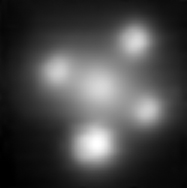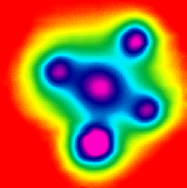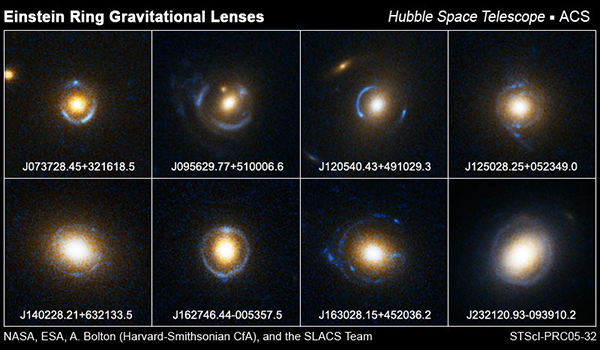 This image from the European Southern Observatory is of the Einstein Cross, a name given to a group of four high redshift quasars (Q2237+030 or QSO 2237+0305) framing the nucleus of the galaxy ZW 2237+030 (QSO 2237+0305 G) also known as Huchra’s Lens located in the constellation Pegasus. The redshift of the nucleus of this spiral galaxy has been measured at 0.0394 z which would place it at a supposed distance of a little over 500 million light-years from Earth using a so-called Hubble Constant value of 75 (km/s)/Mpc. The four quasars all display the same redshift of 1.695 z which would supposedly place them over 20 times further away at a distance of over 10.6 billion light-years.
This image from the European Southern Observatory is of the Einstein Cross, a name given to a group of four high redshift quasars (Q2237+030 or QSO 2237+0305) framing the nucleus of the galaxy ZW 2237+030 (QSO 2237+0305 G) also known as Huchra’s Lens located in the constellation Pegasus. The redshift of the nucleus of this spiral galaxy has been measured at 0.0394 z which would place it at a supposed distance of a little over 500 million light-years from Earth using a so-called Hubble Constant value of 75 (km/s)/Mpc. The four quasars all display the same redshift of 1.695 z which would supposedly place them over 20 times further away at a distance of over 10.6 billion light-years.
However a problem arises when closely examining the galactic nucleus and the four objects that surround it.
 I have taken a close-up image of the Einstein Cross from the ESO site and modified its color palette to produce a false color image as shown at the lower right. To product this image I simply opened the original in Adobe Photoshop, chose Image from the menu bar then Adjustments > Gradient Map… and set the color gradient to one of the preset options available. Changing the color gradient has not modified the pixel positions of the original photograph but has set their assigned colors to a smaller and more visible range according to their brightness. Though faint when viewed in the original grayscale image, in the new color palette connections between the quasars and galactic nucleus are clearly visible. In fact, despite their discordant redshifts, the streaming bridges of material between the objects and the nucleus are undeniable.
I have taken a close-up image of the Einstein Cross from the ESO site and modified its color palette to produce a false color image as shown at the lower right. To product this image I simply opened the original in Adobe Photoshop, chose Image from the menu bar then Adjustments > Gradient Map… and set the color gradient to one of the preset options available. Changing the color gradient has not modified the pixel positions of the original photograph but has set their assigned colors to a smaller and more visible range according to their brightness. Though faint when viewed in the original grayscale image, in the new color palette connections between the quasars and galactic nucleus are clearly visible. In fact, despite their discordant redshifts, the streaming bridges of material between the objects and the nucleus are undeniable.
 Of course, this undeniable proof has not led the scientific community to reexamine their current interpretation of extragalactic redshifts or their adamant belief in the Big Bang Theory. Instead, the existence of the Einstein Cross has been attributed to, of all things, gravitational lensing. But this is a weak explanation at best. There is no valid scientific explanation given as to how a strong gravitational field would bend the light of a directly aligned background object into precisely four point objects. The majority of theories and models of gravitational lensing actually predict a ring effect as the result of the bending of light around a strong source of gravity. In fact there are several gravitational lensing simulations available on the Web that visually demonstrate this effect. However I have yet to find one that simulates the effect supposedly displayed in the Einstein Cross.
Of course, this undeniable proof has not led the scientific community to reexamine their current interpretation of extragalactic redshifts or their adamant belief in the Big Bang Theory. Instead, the existence of the Einstein Cross has been attributed to, of all things, gravitational lensing. But this is a weak explanation at best. There is no valid scientific explanation given as to how a strong gravitational field would bend the light of a directly aligned background object into precisely four point objects. The majority of theories and models of gravitational lensing actually predict a ring effect as the result of the bending of light around a strong source of gravity. In fact there are several gravitational lensing simulations available on the Web that visually demonstrate this effect. However I have yet to find one that simulates the effect supposedly displayed in the Einstein Cross.
Theories, models and simulations can indeed be helpful tools but nothing can match pure scientific observation. There are many examples of gravitational lenses that have been recorded by various observatories and almost all of them are in the shape of rings or arcs. The following image is a small collection of such “Einstein Rings” as observed by the Hubble Space Telescope and made available from the HubbleSite.

It may seem extremely coincidental that four quasars with such exact matching redshifts have been observed in such close proximity to one another, particularly with several visibly connected to, and possibly even emerging from, the nucleus of a central galaxy. However this does not excuse the dismissal of the observations by attempting to apply a misappropriated and improvable theory to them. At the very least continued and improved observations of these objects, as well as all discordant redshift objects, need to be made. Only then will we finally move past the theories and hopefully embrace the facts.
Shannon
 UPDATE: As suggested in the comment below by one of my readers, D R Lunsford, the positions of the objects in the Einstein Cross display tetrahedral symmetry. An excellent example of this symmetry are the four hydrogen atoms surrounding the carbon atom in a molecule of methane.
UPDATE: As suggested in the comment below by one of my readers, D R Lunsford, the positions of the objects in the Einstein Cross display tetrahedral symmetry. An excellent example of this symmetry are the four hydrogen atoms surrounding the carbon atom in a molecule of methane.
The image on the left is the molecular structure of methane generated by a Java applet and rotated to perfectly match the positions of the quasars and central core of the Einstein Cross as also suggested in this reader’s comment. For more information on tetrahedral symmetry as it applies to compact quadruple quasar systems please see my example PG1115+80.
Thanks for the visual aid DRL and thanks again for reading!
Tags: Einstein Cross, Einstein Ring, European Southern Observatory, gravitational lens, gravitational lensing, Hubble Space Telescope, Huchra’s Lens, Pegasus, Q2237+030, QSO 2237+0305, QSO 2237+0305 G, quadruple quasar system, tetrahedral symmetry, ZW 2237+030

OMG, seriously? You really need to read this: http://arxiv.org/abs/astro-ph/9606001
You only need a non-circularly symmetric lens to create four images of a point source in the background. You need an extended source (like a galaxy that’s not too faint) so the different images merge to create the Einstein ring. If you only see the quasar, it would have to be aligned with the center of the galaxy with extraordinarily high precision, and that is not the case.
Cheers.
I suppose one can demonstrate, using optical physics, that images can be split into four separate images arranged in a diamond pattern if viewed through very specifically shaped and oriented lenses. However this does not mean such perfect objects and precise alignments occur in nature on a galactic scale. But even if they did the shape and orientation of the objects in the Einstein Cross do not match those described in this paper. The optically split images described are elongated and widely separated while the four objects of the Einstein Cross are globular and much more closely grouped around the galactic nucleus.
Shannon
The images in the paper are elongated because that would be the effect on an extended source (like a galaxy). With a quasar, the bright source is so small that it would be much less than a pixel on the image. The reason you see “bright blobs” instead of nothing it’s because it’s so bright the effect of the light affects several surrounding pixels. How big you see those blobs in the image of a point source depends on the detector system and the way the picture was taken, and it has to be described when analyzing the data. You need to know about this: http://en.wikipedia.org/wiki/Point_spread_function
The fact that you don’t, is a clear indication that you are in no way qualified to undestand or make accurate interpretations of the data presented in this post. That’s the reason you see “bridges of material” where there are none, for example.
Cheers.
P.S.: There were cases of multiple imaged quasars in which data from more sensitive instruments showed their host galaxies around the bright points of light. The images of these galaxies, being extended sources, were merged together and formed Einstein rings, as predicted. I can search for some of the sources if you don’t believe this.
According to Section 3.5.3 of the paper the images in Figure 19 originate from a “compact source”, not an extended source like a galaxy. I presume compact source to mean a quasar or an active galactic nucleus (AGN) as typically described in most astronomical literature.
I am very familiar with point spread functions but the example I have posted cannot be dismissed as a mere blurry image or instrument aberration. There are other images of the Einstein Cross recorded by various instruments that all show a similar bridge structure. Also it should be noted that the detected photons between adjacent PSFs typically merge to form hourglass shapes along the outer edges, not the thin filaments and bridges shown in the examples on this site.
Yes, and in figure 19 only in one of the positions of the source you get an arc, when the source is crossing the caustic and two of the images merge. In the other 4 you can see you get multiple images (two or four depending on if the source is inside or outside the caustic). That is, only if the compact source is precisely located at the edge of the caustic you get long arcs. If not, you get multiple images.
If you are familiar with point spread functions you will know that they describe the smallest details you can resolve in that particular image. Therefore you can’t assume smaller shapes like those “filaments” are real smaller structure. Furthermore, those filaments appear because the color scheme turns from light blue to dark blue at those levels, so they are misinterpreted as different structures. If you change the color scheme to a different one those “bridges” will disappear or change shape.
Cheers.
In figure 19 the remaining images are basically just shortened arcs, not the globular shapes observed in the Einstein Cross. A similar prediction of this lensing effect was made by Peter Schneider et al. as described in Halton Arp’s book “Seeing Red”. The only copy I could find of this diagram on the Web is located here.
Honestly, I chose the gradient map of the false color image I posted for its aesthetic properties. There are several other preset maps included in Photoshop that show connections between the objects; I have posted a few of these as an image here. Some of these gradient maps show the connections even better than the one I posted, but in my opinion they are not as colorful. Of course there are others that show almost nothing because that is how their colors just happened to be mapped out. And I could have easily created and posted a custom map that shows the connections more vividly than any of the presets but I did not want to be accused of manipulating the data.
By “coincidence”, the five objects are exactly conformable to a tetrahedron with a central object. One could easily imagine that the four outer objects have separated from the core in such a way as to maintain 3D symmetry with respect to the core.
To convince yourself, download a Java applet to display methane in orthographic perspective, and rotate it around until it fits. The fit is exact.
-drl
Yes, I see what you mean, thank you for sharing! I have read about 3D symmetry in compact multiple quasars groups but I never fully grasped the concept until now. I was able to rotate the tetrahedral structure of a Jmol methane model to match the alignment and positioning of the objects in the Einstein Cross, just as you suggested.
You might be interested to know that I was also able to rotate the molecule to match the alignment of the objects in other multiple quasar groups such as PG1115+080 and RXJ0911+0551. The positions of a couple of the quasars appear to be slightly off but perhaps this is caused by the viewing angle and/or the independent motion of the quasars since their ejections from the cores?
Thanks for this information. Can you advise if redshift measures have been made of the other “Einstein Ring” examples, of the claimed distorted galaxies in addition to the central mass, as with the examples given in that Hubble post-up you include above? To my eye, many of them appear more like a galaxy but where the normal spiral arm bands simply remain in a circle. Turn them on edge a bit and they’d not be identifiable as any kind of ring at all! How then about other galaxy redshift measures, contrasting the core versus the arm-bands?
You’re welcome! The Hubble images I posted are part of the Sloan Lens ACS Survey (SLACS). For more information on the survey including redshifts and spectroscopy for the above examples and several others please visit the links on the following page: http://hubblesite.org/news_release/news/2005-32
As far as I’m aware spectral analyses of the light from galactic cores when compared to their spiral arms reveal no significant differences in redshifts other than what is attributed to rotational motion. I find this intriguing especially considering that the orbital velocities of stars within a galaxy are the same regardless of their distance from the core.
I find the shunning of alternative theories by the establishment here regarding redshift, matches what is seen in other fields of study:
establishment economics versus Austrian economics (mises.org)
establishment nutrition and health (especially diabetes and cardiovascular health) versus the information presented by robbwolf.com and chriskresser.com
so it fits a pattern. I hope this encourages you to continue!